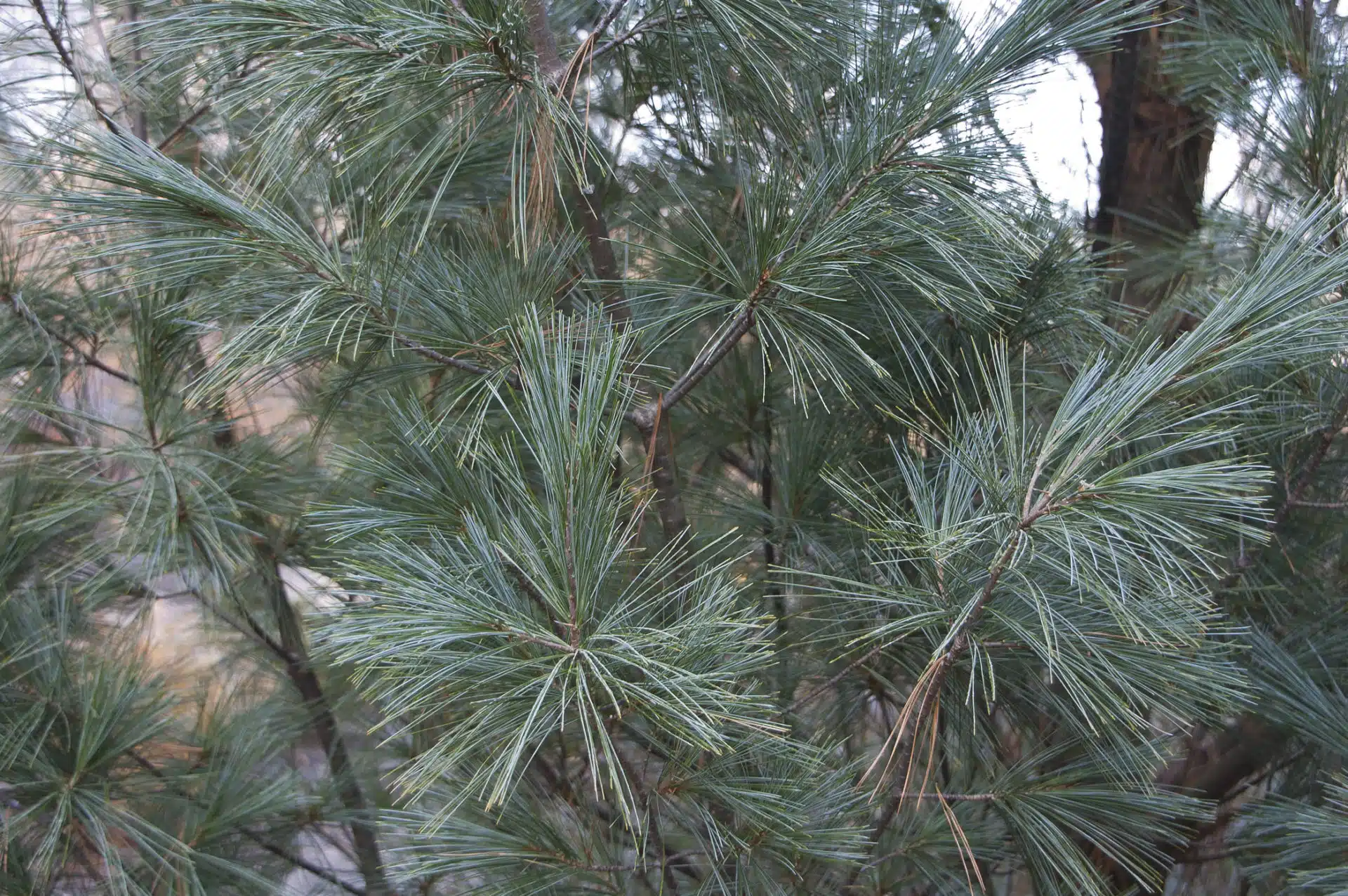Nature Profile
Trees
Eastern white pine
Pinus strobus

Pinus strobus is The Holden Arboretum’s most majestic evergreen. The white pines on Little Mountain can be seen three miles away from Holden’s Conifer Collection at the intersection of Kirtland-Chardon and Sperry roads. This remarkable species is native from southeastern Manitoba and northeastern Iowa to the Great Lake States, including scattered populations in Ohio; east to Newfoundland, south to Georgia in the mountains. There are also isolated stands of Pinus strobus var. chiapensis more than 1,000 miles away in Mexico and Guatemala, although these are considered a distinct species by some authorities.
This pino blanco grows alongside different pines, oaks (Quercus), sweetgum (Liquidambar styraciflua), beech (Fagus grandifolia ssp. mexicana), black cherry (Prunus serotina), magnolias and other trees similar to those found in our woods. On Little Mountain associates include Canada hemlock (Tsuga canadensis), maples (Acer), oaks, American beech (Fagus grandifolia), cucumbertree (Magnolia acuminata) and yellow birch (Betula alleghaniensis).
Pinus strobus has been an important timber tree since the 17th century and was used as masts for the Royal Navy, the first shipment leaving Portsmouth, N.H. in 1634. In 1711, the English Parliament passed a law that made all white pines over 24 inches in diameter one foot above the ground, which were not privately owned, the property of Queen Anne of England. New England lumbermen were incensed by this law and regularly circumvented it. A year before the Boston Tea Party, on April 14, 1772 after a local man was fined for cutting white pines belonging to King George III, a skirmish between angry citizens and two regiments of soldiers occurred in Weare, N. H. at the Pine Tree Tavern in what has since been known as the Pine Tree Riot. A few years later, in 1775 at Bunker Hill, colonial troops marched into battle under a flag depicting a white pine.
At The Holden Arboretum, on Michigan Hill south of Buttonbush Bog, one of the white pines planted in 1939 has now reached 115 feet while a sibling planted east of Sherwin Pond in the Helen S. Layer Rhododendron Garden is 100’. At Lantern Court, a white pine planted in the early 1930s by Warren Corning is 105 feet tall and 36 inches in diameter at breast height (DBH). Just to the northwest of this tree is a 90’ sibling, and to the northeast was a third white pine about 110’ tall whose trunk broke at 40’ in an April, 2011 windstorm and fell into the circle in front of the house. Tending to shed limbs especially in winter storms, Pinus strobus should be kept well away from buildings and drives. It is generally not a good city tree, being prone to damage from air pollution and salt.
In the Layer Rhododendron Garden, west of Heath Pond, is an upright white pine, Pinus strobus ‘Fastigiata’ that was obtained as a 12 inch grafted plant in September 1965, and planted in 1967. Its young branches are held at an angle of about 30 degrees from the leader until decades of growth and weather bring them down closer to the horizontal branching habit that is typical for the species. This tree now measures about 85’ tall with a spread of 43’ and a DBH of 28”. In the Eliot and Linda Paine Rhododendron Discovery Garden, three specimens of a newer selection of upright white pine with even more acute branching angles, Pinus strobus ‘Stowe Pillar’ were planted in September 2012. These trees are now between 9.5-11’ tall and about 4’ wide. Narrowly upright cultivars are useful in that their form is not disfigured by the white pine weevil that can destroy the leader and the symmetry of the typical species.
Approximately 200 cultivars of white pine have been described and more than 100 of them are dwarf. Dwarf conifers come from witch’s brooms, or congested masses of twigs and foliage that are the result of spontaneous genetic bud mutations. Grafts are made directly from witch’s brooms or if a broom bears cones, the seed yields progeny with varying growth rates, about 50 percent being normal with others being dwarf or intermediate. The American Conifer Society classifies dwarf conifers as having average growth rates >1”-6”/year, intermediate >6”-12”/yr., standard >12”/yr. The slowest growing white pine cultivar I am aware of is ‘Julian Pott’, named after the Chesterland, Ohio nurseryman (spelled Pot) who raised it as a seedling from a witch’s broom. It is reported to grow only 10” tall by 6” wide after 10 years and so falls into the miniature category of 1” or less/yr.
The species is useful in creating shelter belts such as the one in Holden’s crabapple collection. The graceful weeping forms including ‘Angel Falls’ and ‘Niagara Falls’ can be left to cascade down a wall, over rocks or staked and trained as a specimen or even into an arch. The dwarf forms, especially those with curly needles such as ‘Squiggles’ and ‘Wiggles’ are cute additions to mixed borders or island beds. All have soft needles and a wonderful aroma that keeps the garden air fresh year round.
White pines transplant readily. Pruning of live branches is best left until summer or fall when their pitch will not be oozing out and streaming down the trunk as it does in spring. Young saplings can be made dense and full by shortening the new shoots or “candles” in spring before they harden. Decorations made of white pine include Christmas trees, swags and garlands. Pinus strobus is the state tree of Michigan and of Maine, where the pine cone and tassel are also considered to be the state flower.




